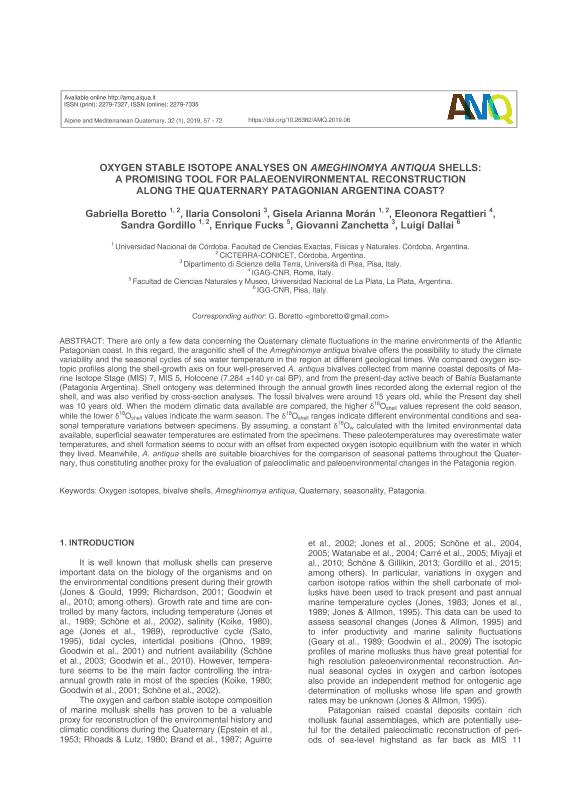Mostrar el registro sencillo del ítem
dc.contributor.author
Boretto, Gabriella Margherita

dc.contributor.author
Consoloni, Ilaria
dc.contributor.author
Morán, Ariana Gisela

dc.contributor.author
Regattieri, Eleonora
dc.contributor.author
Gordillo, Sandra

dc.contributor.author
Fucks, Enrique Eduardo

dc.contributor.author
Zanchetta, Giovanni

dc.contributor.author
Dallai, Luigi
dc.date.available
2021-02-12T20:39:45Z
dc.date.issued
2019-07
dc.identifier.citation
Boretto, Gabriella Margherita; Consoloni, Ilaria; Morán, Ariana Gisela; Regattieri, Eleonora; Gordillo, Sandra; et al.; Oxygen stable isotope analyses on ameghinomya antiqua shells: A promising tool for palaeoenvironmental reconstruction along the quaternary patagonian Argentina coast?; Associazione Italiana per lo Studio del Quaternario; Alpine and Mediterranean Quaternary; 32; 1; 7-2019; 57-72
dc.identifier.issn
2279-7327
dc.identifier.uri
http://hdl.handle.net/11336/125659
dc.description.abstract
There are only a few data concerning the Quaternary climate fluctuations in the marine environments of the Atlantic Patagonian coast. In this regard, the aragonitic shell of the Ameghinomya antiqua bivalve offers the possibility to study the climate variability and the seasonal cycles of sea water temperature in the region at different geological times. We compared oxygen isotopic profiles along the shell-growth axis on four well-preserved A. antiqua bivalves collected from marine coastal deposits of Marine Isotope Stage (MIS) 7, MIS 5, Holocene (7.284 ±140 yr cal BP), and from the present-day active beach of Bahia Bustamante (Patagonia Argentina). Shell ontogeny was determined through the annual growth lines recorded along the external region of the shell, and was also verified by cross-section analyses. The fossil bivalves were around 15 years old, while the Present day shell was 10 years old. When the modern climatic data available are compared, the higher δ18Oshell values represent the cold season, while the lower δ18Oshell values indicate the warm season. The δ18Oshell ranges indicate different environmental conditions and seasonal temperature variations between specimens. By assuming, a constant δ18Ow calculated with the limited environmental data available, superficial seawater temperatures are estimated from the specimens. These paleotemperatures may overestimate water temperatures, and shell formation seems to occur with an offset from expected oxygen isotopic equilibrium with the water in which they lived. Meanwhile, A. antiqua shells are suitable bioarchives for the comparison of seasonal patterns throughout the Quaternary, thus constituting another proxy for the evaluation of paleoclimatic and paleoenvironmental changes in the Patagonia region.
dc.format
application/pdf
dc.language.iso
eng
dc.publisher
Associazione Italiana per lo Studio del Quaternario
dc.rights
info:eu-repo/semantics/openAccess
dc.rights.uri
https://creativecommons.org/licenses/by-nc-sa/2.5/ar/
dc.subject
AMEGHINOMYA ANTIQUA
dc.subject
BIVALVE SHELLS
dc.subject
OXYGEN ISOTOPES
dc.subject
PATAGONIA
dc.subject
QUATERNARY
dc.subject
SEASONALITY
dc.subject.classification
Geociencias multidisciplinaria

dc.subject.classification
Ciencias de la Tierra y relacionadas con el Medio Ambiente

dc.subject.classification
CIENCIAS NATURALES Y EXACTAS

dc.title
Oxygen stable isotope analyses on ameghinomya antiqua shells: A promising tool for palaeoenvironmental reconstruction along the quaternary patagonian Argentina coast?
dc.type
info:eu-repo/semantics/article
dc.type
info:ar-repo/semantics/artículo
dc.type
info:eu-repo/semantics/publishedVersion
dc.date.updated
2020-11-25T16:12:21Z
dc.identifier.eissn
2279-7335
dc.journal.volume
32
dc.journal.number
1
dc.journal.pagination
57-72
dc.journal.pais
Italia

dc.description.fil
Fil: Boretto, Gabriella Margherita. Consejo Nacional de Investigaciones Científicas y Técnicas. Centro Científico Tecnológico Conicet - Córdoba. Centro de Investigaciones en Ciencias de la Tierra. Universidad Nacional de Córdoba. Facultad de Ciencias Exactas Físicas y Naturales. Centro de Investigaciones en Ciencias de la Tierra; Argentina
dc.description.fil
Fil: Consoloni, Ilaria. Università degli Studi di Pisa; Italia
dc.description.fil
Fil: Morán, Ariana Gisela. Consejo Nacional de Investigaciones Científicas y Técnicas. Centro Científico Tecnológico Conicet - Córdoba. Centro de Investigaciones en Ciencias de la Tierra. Universidad Nacional de Córdoba. Facultad de Ciencias Exactas Físicas y Naturales. Centro de Investigaciones en Ciencias de la Tierra; Argentina
dc.description.fil
Fil: Regattieri, Eleonora. Consiglio Nazionale delle Ricerche; Italia
dc.description.fil
Fil: Gordillo, Sandra. Consejo Nacional de Investigaciones Científicas y Técnicas. Centro Científico Tecnológico Conicet - Córdoba. Centro de Investigaciones en Ciencias de la Tierra. Universidad Nacional de Córdoba. Facultad de Ciencias Exactas Físicas y Naturales. Centro de Investigaciones en Ciencias de la Tierra; Argentina
dc.description.fil
Fil: Fucks, Enrique Eduardo. Universidad Nacional de La Plata. Facultad de Ciencias Naturales y Museo; Argentina
dc.description.fil
Fil: Zanchetta, Giovanni. Università degli Studi di Pisa; Italia
dc.description.fil
Fil: Dallai, Luigi. Istituto di Geoscienze e Georisorse; Italia
dc.journal.title
Alpine and Mediterranean Quaternary
dc.relation.alternativeid
info:eu-repo/semantics/altIdentifier/doi/http://dx.doi.org/10.26382/AMQ.2019.06
dc.relation.alternativeid
info:eu-repo/semantics/altIdentifier/url/http://amq.aiqua.it/index.php/issues-2012-2017/amq-32-1-proof-copy/1040-oxygen-stable-isotope-analyses-on-ameghinomya-antiqua-shells-a-promising-tool-for-palaeoenvironmental-reconstruction-along-the-quaternary-patagonian-argentina-coast/file%20%3E
Archivos asociados
